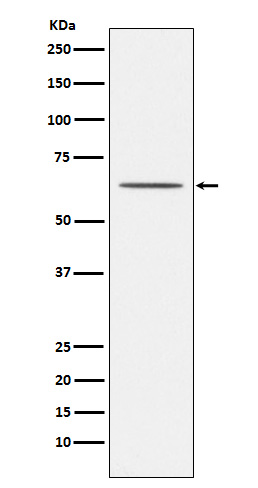
| WB | 咨询技术 | Human,Mouse,Rat |
| IF | 1/20-1/50 | Human,Mouse,Rat |
| IHC | 咨询技术 | Human,Mouse,Rat |
| ICC | 技术咨询 | Human,Mouse,Rat |
| FCM | 咨询技术 | Human,Mouse,Rat |
| Elisa | 咨询技术 | Human,Mouse,Rat |
| Aliases | NgR; Nogo 66 receptor; Nogo receptor; Nogor; Reticulon 4 receptor; Rtn4r;;Reticulon 4 receptor |
| WB Predicted band size | Calculated MW: 51 kDa ; Observed MW: 66 kDa |
| Host/Isotype | Rabbit IgG |
| Antibody Type | Primary antibody |
| Storage | Store at 4°C short term. Aliquot and store at -20°C long term. Avoid freeze/thaw cycles. |
| Species Reactivity | Human,Mouse |
| Immunogen | A synthesized peptide derived from human Reticulon 4 receptor |
| Formulation | Purified antibody in PBS with 0.05% sodium azide,0.05% BSA and 50% glycerol. |
+ +
以下是3篇关于Nogo受体(NgR)抗体的研究文献概述:
---
1. **文献名称**: "Blockade of Nogo-66. Myelin-Associated Glycoprotein, and Oligodendrocyte Myelin Glycoprotein by Soluble Nogo Receptor Enhances Axonal Regeneration"
**作者**: Li, S., Kim, J.E., Budel, S., et al.
**摘要**: 该研究报道了一种可溶性Nogo受体(sNgR)中和抗体,通过阻断NgR与髓鞘抑制分子(如Nogo-66、MAG、OMgp)的相互作用,显著促进脊髓损伤后轴突再生和运动功能恢复。实验在大鼠模型中验证了其促进神经可塑性的效果。
---
2. **文献名称**: "Anti-Nogo-A Antibody Treatment Promotes Recovery of Manual Dexterity after Cervical Cord Injury in Adult Primates"
**作者**: Freund, P., Wannier, T., Schmidlin, E., et al.
**摘要**: 研究团队在灵长类动物模型中应用抗Nogo-A抗体,发现其能显著改善颈段脊髓损伤后的手部精细运动功能。抗体通过抑制NgR信号通路,减少了髓鞘相关生长抑制,促进了皮质脊髓束的再生和功能重组。
---
3. **文献名称**: "Nogo Receptor Antibody Improves Cognitive Function by Reducing Amyloid Plaques and Neuroinflammation in Alzheimer's Disease Mice"
**作者**: Zhang, Y., Huang, Y., Xu, J., et al.
**摘要**: 该研究在小鼠阿尔茨海默病模型中,使用抗NgR抗体干预后发现,其通过调节神经炎症反应和β-淀粉样蛋白沉积,显著改善认知功能。抗体可能通过阻断NgR与Aβ的相互作用,缓解突触功能障碍。
---
这些文献涵盖了NgR抗体在脊髓损伤修复、运动功能恢复及神经退行性疾病中的潜在治疗价值。如需具体文章链接或更多细节,可进一步检索PubMed或相关数据库。
NogoReceptor (NgR1), also known as the Nogo-66 receptor 1. is a key protein implicated in the regulation of axonal growth and neural plasticity within the central nervous system (CNS). Identified in the early 2000s, NgR1 binds to myelin-associated inhibitors (MAIs) such as Nogo-A, MAG, and OMgp, which are expressed in CNS myelin and act as potent suppressors of neurite outgrowth. These inhibitory signals are critical for maintaining neural circuit stability but hinder axon regeneration following injury, contributing to the limited regenerative capacity of the adult CNS.
NgR1 is a glycosylphosphatidylinositol (GPI)-anchored receptor, part of a larger receptor complex that includes co-receptors like p75NTR, TROY, or LINGO-1. which transduce inhibitory signals via the RhoA/ROCK pathway. This signaling cascade leads to cytoskeletal destabilization, growth cone collapse, and ultimately, failure of axonal repair. Antibodies targeting NgR1 (anti-NgR1 antibodies) aim to block its interaction with MAIs, thereby neutralizing inhibitory signaling and promoting axonal sprouting or regeneration.
Preclinical studies in spinal cord injury and stroke models have shown that NgR1 antibodies enhance functional recovery, making them promising therapeutic candidates for CNS trauma and neurodegenerative diseases. However, challenges remain, including optimizing specificity, delivery across the blood-brain barrier, and balancing regenerative effects with potential disruptions to neural plasticity. Current research focuses on refining antibody design and exploring combinatorial approaches with other pro-regenerative therapies.
×